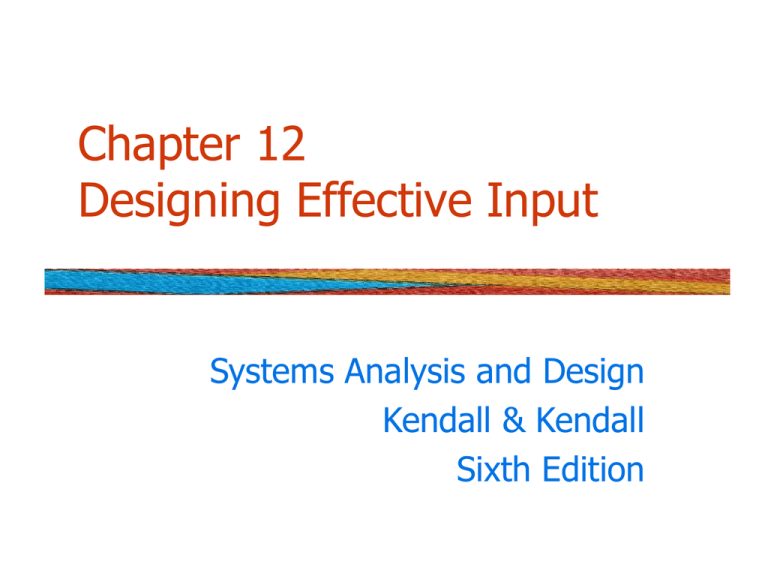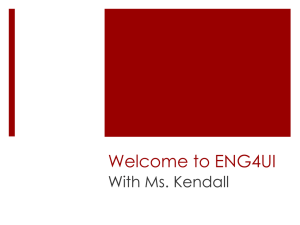
Chapter 12
Designing Effective Input
Systems Analysis and Design
Kendall & Kendall
Sixth Edition
Major Topics
• Input design
• Form design
• Display design
• GUI screen design
• GUI controls
• Web design guidelines
Kendall & Kendall
© 2005 Pearson Prentice Hall
12-2
Input Design Objectives
•
•
The quality of system input determines the
quality of system output.
Well-designed input objectives:
• Effectiveness.
• Accuracy.
• Ease of use.
• Consistency.
• Simplicity.
• Attractiveness.
Kendall & Kendall
© 2005 Pearson Prentice Hall
12-3
Form Design
Guidelines for good form design:
• Make forms easy to fill out.
• Ensure that forms meet the purpose for
which they are designed.
• Design forms to assure accurate
completion.
• Keep forms attractive.
Kendall & Kendall
© 2005 Pearson Prentice Hall
12-4
Form Completion
To make forms easy to fill out, the
following techniques are used:
• First, design forms with proper flow, from
left to right and top to bottom.
• Second, group information logically using
the seven sections of a form.
• Third, provide people with clear captions.
• Captions tell the person completing the form
what to put on a blank line, space, or box.
Kendall & Kendall
© 2005 Pearson Prentice Hall
12-5
Seven Sections of a Form
The seven sections of a form are:
• Heading.
• Identification and access.
• Instructions.
• Body.
• Signature and verification.
• Totals.
• Comments.
Kendall & Kendall
© 2005 Pearson Prentice Hall
12-6
Seven Sections of a Form
Kendall & Kendall
© 2005 Pearson Prentice Hall
12-7
Caption Types
Captions may be one of the following:
• Line caption, putting the caption on the
same line or below the line.
• Boxed caption, providing a box for data
instead of a line.
• Vertical check off, lining up choices or
alternatives vertically.
• Horizontal check off, lining up choices or
alternatives horizontally.
Kendall & Kendall
© 2005 Pearson Prentice Hall
12-8
Caption Types
Kendall & Kendall
© 2005 Pearson Prentice Hall
12-9
Meeting the Intended Purpose
• Systems analysts may use different types
of specialty forms for different purposes.
• Specialty forms can also mean forms
prepared by a stationer.
Kendall & Kendall
© 2005 Pearson Prentice Hall
12-10
Ensuring Accurate Completion
• To reduce error rates associated with
data collection, forms should be
designed to assure accurate completion.
• Design forms to make people do the
right thing with the form.
• To encourage people to complete forms,
systems analysts should keep forms
attractive.
Kendall & Kendall
© 2005 Pearson Prentice Hall
12-11
Attractive Forms
• To be more attractive, forms should
look uncluttered, and elicit information
in the expected order.
• Aesthetic forms or usage of different
fonts and line weights within the same
form can help make it more attractive.
Kendall & Kendall
© 2005 Pearson Prentice Hall
12-12
Computer Form Design
Software
•
•
Numerous microcomputer form design
software is available.
Features of electronic form design software:
• Ability to design paper, electronic, or Web- based
•
•
Kendall & Kendall
forms.
Form design using templates.
Form design by cutting and pasting familiar
shapes and objects.
© 2005 Pearson Prentice Hall
12-13
Computer Form Design
Software (Continued)
• Features of the electronic form design
software
• Facilitates completion through the use of
software.
• Permits customized menus, toolbars,
keyboards, and macros.
• Supports popular databases.
• Enables broadcasting of electronic forms.
• Permits sequential routing of forms.
Kendall & Kendall
© 2005 Pearson Prentice Hall
12-14
Computer Form Design
Software (Continued)
• Features of electronic form design
software
• Assists form tracking.
• Encourages automatic delivery and
processing.
• Establishes security for electronic forms.
Kendall & Kendall
© 2005 Pearson Prentice Hall
12-15
Controlling Business Forms
• Controlling forms include:
• Making sure that each form in use fulfills
its specific purpose.
• Making sure that the specified purpose is
integral to organizational functioning.
• Preventing duplication of information
collected and the forms that collect it.
• Designing effective forms.
Kendall & Kendall
© 2005 Pearson Prentice Hall
12-16
Controlling Business Forms
(Continued)
• Controlling forms include:
•
Deciding on reproduce forms in the most
economical way
• Establishing stock control and inventory
procedures that make forms available
when needed, at the lowest possible cost
Kendall & Kendall
© 2005 Pearson Prentice Hall
12-17
Display Design Guidelines
Guidelines for good display design:
• First, keep the display simple.
• Second, keep the display presentation
consistent.
• Third, facilitate user movement among
display screens.
• Finally, create an attractive display.
Kendall & Kendall
© 2005 Pearson Prentice Hall
12-18
Three Screen Sections
To keep the screen simple, it is divided
into three sections:
• Heading.
• Body.
• Comments and instructions.
Kendall & Kendall
© 2005 Pearson Prentice Hall
12-19
Display Design Concepts for
Simplicity
• Displaying a few necessary basic
commands using windows or hyperlinks
is another way to keep screens simple.
• For the occasional user, only 50 percent
of the screen should contain useful
information.
Kendall & Kendall
© 2005 Pearson Prentice Hall
12-20
Display Design Concepts for
Simplicity (Continued)
• Simplistic design includes maximizing or
minimizing the window size as needed.
• Use context-sensitive help and other
pop-up menus.
• Consistency is achieved by displaying
information in the same area or by
grouping information logically.
Kendall & Kendall
© 2005 Pearson Prentice Hall
12-21
Facilitating Movement
Guidelines for facilitating movement
from one page to another:
• Clicking--the three clicks rule says that
users should be able to get to the screens
they need within three mouse or keyboard
clicks.
• Scrolling--using arrows or PgDn keys.
• Using context-sensitive pop-up windows.
• Using onscreen dialogue .
Kendall & Kendall
© 2005 Pearson Prentice Hall
12-22
Designing an Attractive Screen
To make the screen attractive use:
• Different thickness of separation lines
between subcategories.
• Inverse video and blinking cursors.
• Different combinations of colors.
• Different type fonts.
Kendall & Kendall
© 2005 Pearson Prentice Hall
12-23
Using Icons in Screen Design
• Icons are used in graphical screens to
run programs and execute commands.
• Graphical User Interface (GUI) are used
in conjunction with a mouse, keyboard,
lightpen, or joystick for making
selections and entering data.
Kendall & Kendall
© 2005 Pearson Prentice Hall
12-24
Graphical User Interface (GUI)
Controls
GUI controls or fields:
• Text boxes.
• Check boxes.
• Option or radio buttons.
• List and drop-down list boxes.
• Sliders and spin buttons.
• Image maps.
• Text area.
• Message boxes.
Kendall & Kendall
© 2005 Pearson Prentice Hall
12-25
GUI Screen Example
Kendall & Kendall
© 2005 Pearson Prentice Hall
12-26
Text Boxes
• Text boxes should be large enough to
accommodate all the field characters.
• Captions should be to the left of the
text box.
• Character data should be left aligned
within the box.
• Numeric data right aligned.
Kendall & Kendall
© 2005 Pearson Prentice Hall
12-27
Check Boxes
• Check boxes are used for nonexclusive
choices.
• Check box text or label is placed to the
right of the check box.
• If there are more than 10 check boxes,
group in a bordered box.
Kendall & Kendall
© 2005 Pearson Prentice Hall
12-28
Option Buttons and Drop-down
List Boxes
• Option or radio buttons are used for
exclusive choices.
• Often they are placed in a rectangle
called an option group.
• List and drop-down list boxes are used
to select one choice out of many.
Kendall & Kendall
© 2005 Pearson Prentice Hall
12-29
Sliders, Spin Buttons, and
Image Maps
• Sliders and spin buttons are used to
change data that have a continuous
range of values.
• Image maps are used to select values
within an image.
• The x and y coordinates are sent to the
program.
Kendall & Kendall
© 2005 Pearson Prentice Hall
12-30
Slider and spin button example
Kendall & Kendall
© 2005 Pearson Prentice Hall
12-31
Text Area
• A text area is used for entering a larger
amount of text.
• These areas may have text that wraps
when the text reaches the end of the
box.
• There are two ways to handle the text:
• Hard return is used to force new lines.
• Use word wrap within the text area.
Kendall & Kendall
© 2005 Pearson Prentice Hall
12-32
Message Boxes and Command
Buttons
• Message boxes are used to display
warning and other messages in a
rectangular window.
• Command buttons perform an action.
Kendall & Kendall
© 2005 Pearson Prentice Hall
12-33
Tab Control Dialogue Boxes
• Tab control dialog boxes help organize
GUI features (controls) for users.
• Each tab dialog box should have three
basic buttons:
• OK.
• Cancel.
• Help.
Kendall & Kendall
© 2005 Pearson Prentice Hall
12-34
Web Page Dialogue Boxes
• A new type of dialogue box has the look
and feel of a Web page.
• Buttons are called places and are
hyperlinked to items a user would wish
to access.
Kendall & Kendall
© 2005 Pearson Prentice Hall
12-35
Color
• The five most legible
foreground/background color
combinations for display monitors are:
• Black on yellow.
• Green on white.
• Blue on white.
• White on blue.
• Yellow on black.
Kendall & Kendall
© 2005 Pearson Prentice Hall
12-36
Skins
Skins are graphical overlays that allow
customers to change the appearance of
a Web site depending on their
preferences for a particular kind of
image.
Kendall & Kendall
© 2005 Pearson Prentice Hall
12-37
Internet and Intranet Design
Guidelines
Guidelines for creating intranet and
Internet input pages:
• Provide clear instructions.
• Use a logical entry sequence for fill-in
forms.
• Use a variety of text boxes, push buttons,
radio buttons, drop-down lists, and other
GUI features.
Kendall & Kendall
© 2005 Pearson Prentice Hall
12-38
Internet and Intranet Design
Guidelines
Guidelines for creating intranet and
Internet input pages (continued):
• Provide a scrolling text box if you are
uncertain how much text will be entered.
• Include two basic buttons: Submit and
Clear.
• If the form is lengthy, divide it into several
simpler forms on separate pages.
Kendall & Kendall
© 2005 Pearson Prentice Hall
12-39
Internet and Intranet Design
Guidelines
Guidelines for creating intranet and
Internet input pages (continued):
•
Kendall & Kendall
Create a feedback screen that lists error
messages if a form has not correctly been
filled out
© 2005 Pearson Prentice Hall
12-40
Ecommerce Applications
• Ecommerce applications involve more
than just good Web site design.
• Customers need to be confident of the
site, including privacy and security.
Kendall & Kendall
© 2005 Pearson Prentice Hall
12-41







